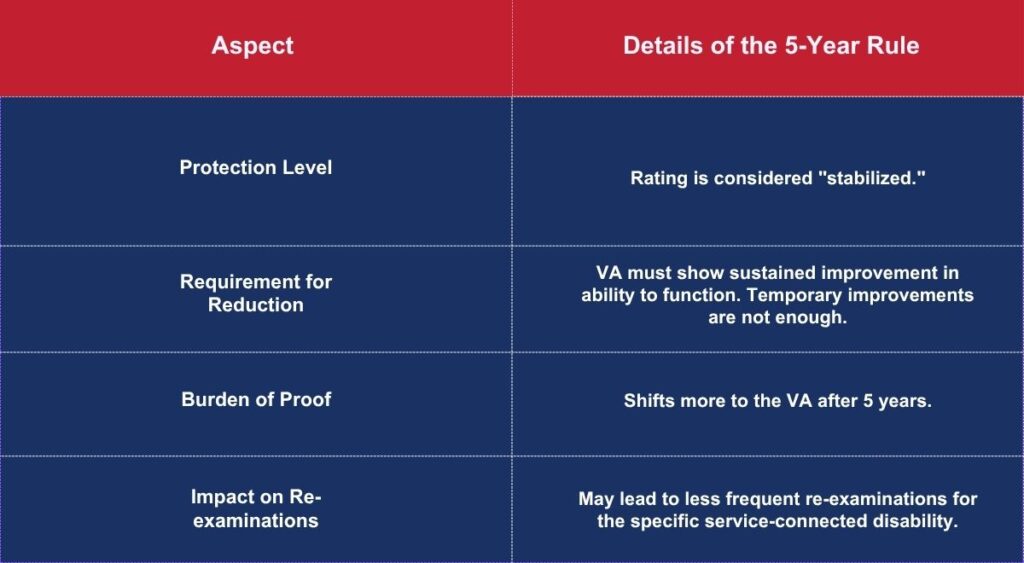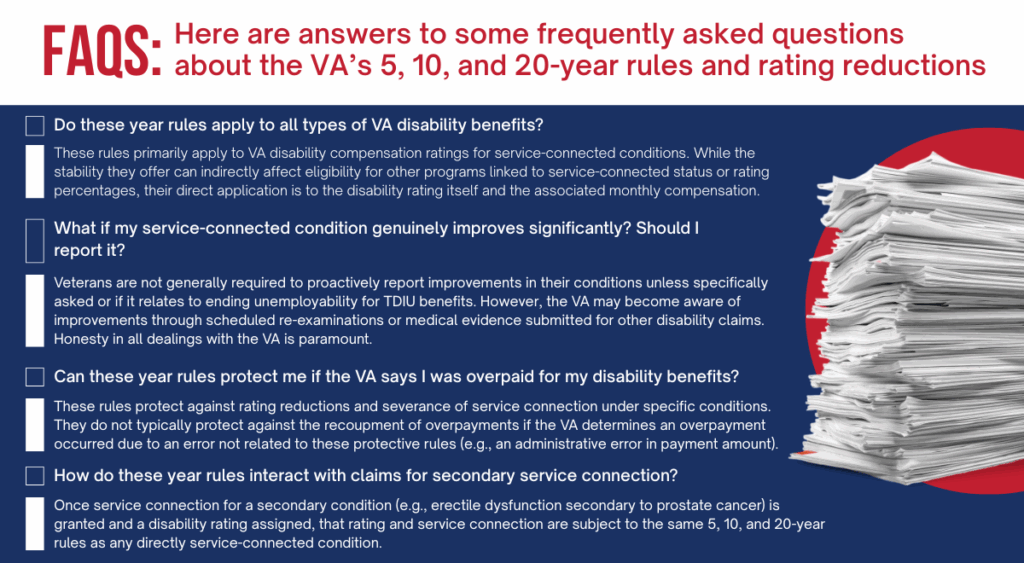
Getting your VA disability rating is a huge step. You fought for it, and it represents acknowledgment of your service-connected conditions. But then a nagging worry might creep in: can the VA take it away or reduce it? This concern is completely understandable for any disabled veteran. The good news is that there are safeguards in place, particularly when you know about the VA’s 5-Year, 10-Year and 20-Year Rules: What to Know explains protections Veterans earn over time against rating reductions. These year rules can give you significant peace of mind, because knowing them is half the battle when dealing with your veteran’s disability. You’ll learn that as time goes on, your VA disability rating can become more secure, thanks to these important VA protections. Learning about these specific year rules helps you understand your rights regarding your disability benefits.
Understanding VA Disability Ratings and Reductions
First, let’s quickly touch on what a VA disability rating is. It’s a percentage, from 0% to 100%, that the VA assigns to show the severity of your service-connected disability or service-connected condition. This VA rating directly impacts the amount of monthly compensation you receive for your condition claims. So, any talk of a rating reduction can naturally cause a lot of stress for a veteran relying on these VA disability benefits.
Why would the VA even think about reducing a rating? Sometimes, it’s because medical evidence suggests a genuine and lasting improvement in your service-related disability. Other times, it could be due to an error found in a previous decision made on your disability claim. The VA has a responsibility to make certain that disability ratings are accurate according to current laws and medical facts.
However, this process can feel scary and uncertain. You’ve likely come to depend on these VA benefits, and the thought of them changing can be unsettling, particularly if you’re managing conditions like chronic pain or a depressive disorder. This is why understanding the protections you’ve earned through these VA year rules is so important for your peace of mind and financial planning.
The Foundation: Why Do These Time-Based Rules Exist?

You might wonder why these specific timeframes—5, 10, and 20 years—even exist for VA disability. The VA attempts to strike a balance. On one hand, they need to correctly rate disabilities based on current medical evidence for all connected conditions. On the other hand, they recognize that Veterans who have lived with a condition for a long time, such as those exposed to Agent Orange or Gulf War toxins, deserve some stability in their veteran’s disability benefits.
These rules acknowledge that the longer a condition has been recognized and rated by the VA, the more established it is considered to be. It reflects an understanding that reducing a long-standing benefit requires a higher degree of certainty about any improvement, particularly for complex issues like traumatic brain injury or mental health conditions. Think of them as milestones that, once reached, offer you more security in your VA disability rating.
While the VA always aims for accuracy in its disability ratings, these rules give a framework for fairness. They help make certain that any changes to your VA disability benefits are carefully considered, especially after a significant period. This framework helps many veterans feel more secure about their future and the monthly compensation they receive.
VA’s 5, 10, and 20-Year Rules: Protections Against Rating Reductions
Let’s break down each of these important rules. Each one builds on the last, giving you stronger protections as time passes for your service-connected disabilities. Knowing how each rule works can empower you to protect your VA claim outcomes.
The 5-Year Rule: Stabilized Ratings
The 5-Year Rule is the first significant milestone for protecting your VA disability rating. If your disability rating has been in place for five years or more, it is considered “stabilized.” This doesn’t mean your VA rating can never be reduced, but it does make it harder for the VA to do so. The VA cannot reduce a stabilized rating unless there is evidence of sustained improvement in your ability to function under the ordinary conditions of life.
So, what does “sustained improvement” actually mean regarding your service-connected condition? This isn’t just about a good week or a temporary dip in symptoms for something like knee pain or neck pain. The VA must show through medical evidence that the improvement is real, lasting, and affects your daily life and work; a single examination showing slight improvement probably won’t be sufficient, as per 38 CFR section 3.344(a). The evidence must be clear and cover a reasonable period, demonstrating that your condition, perhaps degenerative disc disease or lumbosacral strain, has genuinely improved to an extent that affects your overall impairment.
If your rating has been active for less than five years, the VA has a bit more leeway to adjust it if new medical evidence shows your condition has improved or to correct a clear and unmistakable error. But once you cross that five-year mark for a disability rating, the burden of proof shifts more heavily onto the VA. This is why regular medical treatment for conditions like rheumatoid arthritis and keeping meticulous records are so valuable for your disability claims.
This rule often affects how the VA schedules re-examinations for your connected conditions. If a condition is stabilized, they might schedule future exams less frequently, or sometimes not at all, especially if the condition is static, not expected to improve (like some forms of hearing loss), or is a chronic multi-symptom illness.
Here’s a quick summary of the 5-Year Rule:

The 10-Year Rule: Protection Against Severance
Next up is the 10-Year Rule for VA disability benefits. This rule is a big one for peace of mind regarding the service connection of your disability. If the VA has granted service connection for a particular condition, and that grant has been in effect for ten years or more, the VA cannot terminate (or sever) that service connection. This protection is quite strong and applies to conditions established through direct service connection, presumptive service, or even secondary service connection.
There’s one major exception here: fraud. If the VA finds that the original grant of service connection was based on fraudulent actions by the Veteran when making their VA claim, they can still sever the connection, even after ten years. This is clearly stated in 38 U.S.C. section 110. It underscores the importance of honesty in all disability claims.
Now, it’s important to understand what the 10-Year Rule does and doesn’t do for your VA rating. It protects the fact that your condition, be it heart disease linked to Agent Orange or a sleep disorder developed in service, is considered service-connected. However, it does not mean your disability rating percentage for that condition is permanently locked in. If medical evidence clearly shows sustained improvement in your condition, the VA can still reduce the percentage rating, even if the service connection itself is protected. So, a 50% rating could be reduced to 30%, for example, but they can’t say it’s no longer a service-connected disability.
This is another reason why continued medical care and documentation are your allies, especially for conditions like mental health disorders or multi-symptom illnesses that can fluctuate. If your condition genuinely improves, the rating might change. But if it remains the same or worsens, your medical records will support that, safeguarding your VA disability benefits.
The 20-Year Rule: The “Golden Ticket” for Continuous Ratings
The 20-Year Rule offers the highest level of protection for a specific disability rating level. If a disability has been continuously rated at or above a certain percentage for 20 years or more, the VA generally cannot reduce that rating below that established level. This is sometimes called a “continuous rating” and provides substantial security for your VA benefits.
For instance, if you’ve had a rating of 30% for a specific service-connected condition like multiple sclerosis for 20 straight years, the VA cannot typically reduce it below 30%. This provides a very strong safeguard for long-term beneficiaries receiving monthly compensation. The only way the VA can overcome this protection is if they can prove that the original rating, or the one that established the 20-year continuous period, was based on fraud, as outlined in 38 CFR section 3.951(b).
This rule is incredibly powerful for a disabled veteran. It means that after two decades of the VA recognizing your condition, such as chronic pain from shoulder injuries or the effects of military sexual trauma, at a certain severity, that level becomes essentially permanent, barring fraud. This truly helps Veterans, whether they served in the Air Force or Coast Guard, plan their future with much greater certainty about their financial support from VA disability benefits. It recognizes the long-term impact of service-connected disabilities, including severe conditions like amyotrophic lateral sclerosis or somatic symptom disorder.
Think about the difference: the 10-Year rule protects the service connection. The 20-Year rule can protect the actual rating percentage you’ve held for that long period for your service-related disability. It’s a significant milestone for any Veteran managing their veteran’s disability and the associated disability claims process.
Key Considerations and What Can Still Happen

While these year rules give substantial protection, there are a few things to keep in mind. Understanding these nuances can help you avoid potential pitfalls with your VA disability. No protection is absolute if certain conditions are met, particularly when it comes to VA rating reductions.
The biggest exception, as mentioned for each rule, is fraud. If the VA determines that a benefit, such as monthly compensation or even special monthly compensation, was obtained through fraudulent means (e.g., falsifying medical evidence or service records), none of these time-based protections will prevent them from taking action. This could include revoking service connection or reducing disability ratings. Honesty and accuracy in all your dealings with the VA, including every disability claim, are always critical.
You might also wonder about Permanent and Total (P&T) ratings. A P&T rating means the VA has determined your service-connected disabilities are 100% disabling and are not expected to improve, which can often be the case for severe traumatic brain injury or advanced prostate cancer. P&T status itself offers strong protection against reductions because re-examinations are usually not scheduled. These time-based year rules can be relevant if your rating wasn’t P&T initially but later reached one of these milestones, or if for some rare reason a P&T rating is ever re-evaluated. They add layers of security to your veterans disability status.
Attending Compensation and Pension (C&P) exams is crucial for your VA claim. If the VA schedules you for an exam, even if you feel your condition (like hearing loss or erectile dysfunction) is protected by one of these rules, you generally must attend. Failure to attend without a good reason can lead the VA to propose a reduction or even termination of VA benefits based on non-cooperation. Always communicate with the VA if you have issues with a scheduled exam, as this is vital for processing VA disability claims.
Finally, think about submitting new medical evidence or filing new condition claims. If you file a VA claim for an increase for one condition, or for a new service-connected disability perhaps due to toxic exposure, the VA might review your entire file. If they find evidence of improvement in another, separate condition (like degenerative disc disease) that’s subject to these rules, they could initiate a proposal to reduce that other condition’s disability rating. It’s always good to be aware of how different actions can impact your overall VA disability benefits picture, including TDIU benefits which rely on underlying disability ratings.
What to Do if You Receive a Proposal to Reduce Your Rating
Receiving a letter from the VA proposing to reduce your disability rating can be alarming. Your first instinct might be to panic, but try to stay calm because there is a process to follow and you have rights regarding your VA rating. This applies whether the proposed rating reduction is for a physical condition like knee pain or a mental health issue.
The first step is to carefully read the notice from the VA. It should explain why they are proposing the rating reduction and list the medical evidence they used to make that preliminary decision. Understanding their reasoning is essential to formulating your response and protecting your disability benefits.
You have important rights in this situation concerning your VA disability rating. Typically, the VA will give you 60 days from the date of the letter to submit evidence arguing against the reduction of your service-connected disability. You also have 30 days to request a personal hearing. Don’t miss these deadlines; they are critical for your disability claim and any potential disability appeals.
A hearing gives you a chance to explain, in person or virtually, why your disability rating should not be reduced. You can present arguments and point to evidence supporting your level of veteran’s disability. It’s an opportunity for the VA to hear directly from you about how your service-connected conditions, like chronic multi-symptom illnesses or a somatic symptom disorder, continue to affect you. Gathering new evidence is also vital. This might include updated medical records from your doctors, letters from specialists (especially for conditions like heart disease or multiple sclerosis), or “buddy statements” from friends, family, or fellow service members who can attest to your condition’s severity.
Protecting Your Hard-Earned Benefits
Understanding these year rules is a great first step, but there are proactive measures you can take to help protect your VA benefits. Being diligent about your healthcare and your VA correspondence plays a big part in managing your disability claims. It’s about being informed and engaged in the process concerning your VA disability.
Continuing to get regular medical treatment for your service-connected conditions is very important. This not only helps manage your health, whether it’s for lumbosacral strain, neck pain, or a depressive disorder, but also creates an ongoing medical record. This record can be vital if the VA ever questions the severity or persistence of your conditions and proposes a rating reduction. This is especially true for conditions presumed linked to service, like those from Agent Orange or Gulf War toxic exposure.
Always make certain the VA has your current mailing address. If they send important notices, like a proposal to reduce benefits or an exam schedule for your service-connected disability, to an old address, you might miss crucial deadlines. This simple step can prevent a lot of problems with your VA claim and disability benefits. This also applies to Guard VA benefits for members of the National Guard or Reserves.
Beyond the practical steps, just knowing that these protections like the 5, 10, and 20-year rules exist can reduce anxiety. It shows that the system has mechanisms to provide stability over time for your veteran’s disability. While not foolproof, they offer a significant measure of security for your monthly compensation and potentially special monthly compensation. This knowledge empowers you to understand what to expect and how to advocate for yourself if needed, perhaps even using a disability calculator for estimations but relying on official VA processes.

Frequently Asked Questions (FAQs)
Here are answers to some frequently asked questions about the VA’s 5, 10, and 20-year rules and rating reductions:

- Do these year rules apply to all types of VA disability benefits?
These rules primarily apply to VA disability compensation ratings for service-connected conditions. While the stability they offer can indirectly affect eligibility for other programs linked to service-connected status or rating percentages, their direct application is to the disability rating itself and the associated monthly compensation. - What if my service-connected condition genuinely improves significantly? Should I report it?
Veterans are not generally required to proactively report improvements in their conditions unless specifically asked or if it relates to ending unemployability for TDIU benefits. However, the VA may become aware of improvements through scheduled re-examinations or medical evidence submitted for other disability claims. Honesty in all dealings with the VA is paramount. - Can these year rules protect me if the VA says I was overpaid for my disability benefits?
These rules protect against rating reductions and severance of service connection under specific conditions. They do not typically protect against the recoupment of overpayments if the VA determines an overpayment occurred due to an error not related to these protective rules (e.g., an administrative error in payment amount). - Do these rules apply to proposed reductions for conditions related to military sexual trauma (MST) or toxic exposure?
Yes, these rules apply to all service-connected disabilities, regardless of their origin, including those resulting from military sexual trauma, Agent Orange exposure, Gulf War illnesses, or other forms of toxic exposure, provided the time criteria are met for the specific VA rating or service connection. - How do these year rules interact with claims for secondary service connection?
Once service connection for a secondary condition (e.g., erectile dysfunction secondary to prostate cancer) is granted and a disability rating assigned, that rating and service connection are subject to the same 5, 10, and 20-year rules as any directly service-connected condition. - What about Guard VA benefits? Do these rules apply similarly to National Guard or Reserve members?
Yes, if a National Guard or Reserve member has established service connection for a disability incurred or aggravated during active duty, active duty for training, or inactive duty training, and receives a VA disability rating, these protective year rules apply to their VA disability benefits in the same way they apply to other veterans. - Does presumptive service connection for conditions have different protections?
Presumptive service connection makes it easier to establish that a condition is service-connected (e.g., certain conditions for veterans with Agent Orange exposure). Once service connection is granted on a presumptive basis and a VA rating is assigned, that rating and service connection are then subject to the 5, 10, and 20-year rules like any other service-connected disability. The protection is on the granted connection and rating, not the method of establishing connection.
Conclusion
The journey through the VA disability system can feel long, but protections for your VA disability benefits do build over time. The VA’s 5-Year 10-Year and 20-Year Rules give increasing layers of security against unwarranted rating reductions to your disability ratings. Knowing that your VA rating for a chronic condition, such as chronic pain or a long-standing depressive disorder, can become stabilized after five years gives some comfort. Reaching the ten-year mark and knowing your service connection is largely permanent is a bigger relief for your veterans disability status. And finally, the twenty-year rule protecting a continuous rating level is a very strong safeguard for your future financial stability and peace of mind, particularly for those relying on their disability claim outcomes for conditions like traumatic brain injury or heart disease.
Understanding the VA’s 5-Year 10-Year and 20-Year Rules: What to Know Explains protections Veterans earn over time against rating reductions. can make a real difference. This knowledge is vital for managing your VA disability benefits and preparing for any disability appeals should the need arise. It ensures you are better equipped to handle your interactions with the VA regarding your service-connected disabilities.
Stay informed about your VA benefits, keep up with your medical care for all service-connected conditions, and know your rights as a disabled veteran. These rules are in place to provide a degree of certainty as you manage your health and plan your life based on the VA disability compensation you rightly earned through your service, whether you served in the Army, Navy, Air Force, Marines, or Coast Guard.

